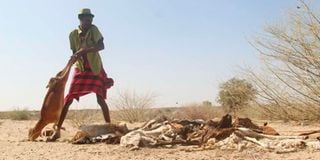This is how Africa can solve food challenges in post-pandemic era

A herder dumps a dead goat onto a pile of carcasses in Illeret, Marsabit County. The devastating drought in Northern Kenya has left pastoralist communities without pasture leading to death of hundreds of thousands of livestock.
The African Union declared 2022 the Year of Food Security and Nutrition, yet several factors have left millions facing starvation. From drought to rising fuel and energy prices, coupled with record-high prices of basic food commodities, malnutrition and hunger have become the new reality for many children and their families.
Just when millions of households were recovering from the effects of the Covid-19 pandemic, things seem to get worse.
An estimated 38.3 million people across Africa face acute food insecurity between June and August. This number is expected to rise to an unprecedented level if humanitarian interventions are not scaled up. The number of people affected in West and Central Africa was expected to reach a record high this month, quadrupling in just three years from 10.7 million in 2019 to 41 million in 2022.
IGAD reports that 29 million people in eastern Africa face high levels of food insecurity due to prolonged drought.
Severe hunger
In eastern and northern Kenya, most arid and semi-arid lands are experiencing critical drought conditions, leaving 3.5 million people facing severe hunger. About 755,000 children under five and 103,000 pregnant and/or lactating women risk cute malnutrition. National Drought Management Authority data show 1.5 million livestock died between last October and March. Water sources have dried up, increasing trekking distances to access the commodity as more children drop out of school to join their parents in the search.
The inflation rate rose to 7.1 per cent in May, the highest since February 2020, and the cost of basic food commodities is rising sharply. This situation is replicated in several countries. In Uganda, households and traders are grappling with record-high prices of essential commodities like wheat and sunflower oil.
Russia’s invasion of Ukraine has affected exports from the two countries, which account for 26 per cent of wheat exports globally and 80 per cent of sunflower oil , according to the Food and Agriculture Organization (FAO). Fourteen African countries depend on the two for more than half of their wheat imports. FAO warns that the conflict could lead to as many as 13.1 million people going hungry between 2022 and 2026 globally.
Biggest victims
The biggest victims are children, girls and women. Pregnant and breastfeeding women, in particular, are at greater risk of malnutrition and stress. Traditionally, when food is scarce, women eat last, least or not at all while children lack access to adequate, let alone nutritious, foods.
Concerted efforts are required urgently. Governments, development partners, corporations, donors, communities and the media must work together for sustainable solutions, prioritising investment in environmentally sustainable and resilient food systems that are inclusive of the poor and marginalised.
Cushioning food-insecure households is necessary. For instance, there is a need to implement school feeding programmes in the worst-hit areas to help children to continue with their education. In some cases, this is the only meal a child will have in a day. Reviving mobile schools that follow the pastoralists as they move with their children and livestock is another potential intervention.
Scale up provision of adequate nutritious foods and healthcare services for pregnant and nursing mothers. Domestic price controls, social protection programmes, food subsidies and export restrictions will also help to alleviate the crisis.
Vulnerable households in urban and rural areas must be supported to enjoy their right to adequate food. These are typically the most affected by high food prices since their purchasing power is eroded, affecting other facets of their lives and harming their overall wellbeing.
In the medium- and long term, food sustainability and self-sufficiency must be Africa’s goal. The continent remains an overly dependent importer of food despite hosting 60 per cent of the world’s arable land. Stakeholders must pool their resources to support development of agriculture, livestock and fisheries in Africa, which will guarantee enhanced and sustainable food production.
Mr Ngugi is Africa regional director, ChildFund International.





